South India Tour
Temples, fishnets, rainforest and picture perfect beaches
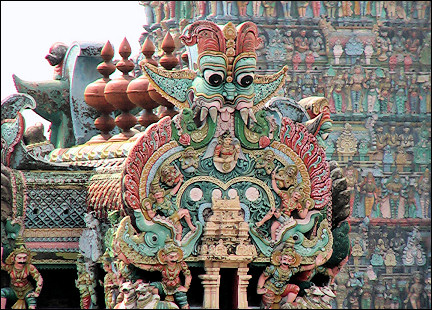
|
The original population of South India are the Dravidians. In Madurai, Thanjavur, Trichy and Mamallapuram are impressive temples. On the coast, there is salt mining, rice and sugarcane are grown and fishing is done with nets. In the Backwaters near Allepey people live on and in the water. In the mountains are rainforests, tea plantations and pineapple, rubber and coffee are grown there.
Travelogue & photos: Johan Siegers
Pondicherry
The flowers in the market are for the gods
For breakfast we have pancakes with curry in our hotel in Chennai, formerly Madras. They also offer toast, but we're in India, so we have an Indian breakfast.
Traffic in Chennai, the capital of Tamil Nadu, is chaotic. Overtaking left and right alike is quite normal and there is so much honking that it has lost all meaning. When we leave Chennai, the half-finished city slowly makes place for the green coast of Tamil Nadu.
The water here is salty, so there's not much that will grow here. Mainly rice, sugarcane and palmtrees. During the 2004 tsunami, much was destroyed. The small, newly planted palmtrees are reminders of the destruction that took place.
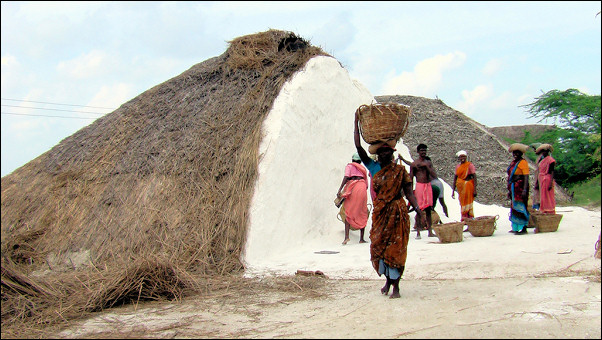
Salt is mined here. Strips of land are flooded and the water is left to evaporate. The wet salt is left on the ground to dry out completely.
In Pondicherry we stroll through the shopping streets and visit a vegetable and flower market. Flowers are often used to make necklaces and other decorations, usually to honor some deity.
We also meet our first beggars. It's hard to estimate if they are really needy. A rice grower earns about 80 Rs per day. Beggars can also collect this amount, especially if they carry a child. Children are sometimes sent out to beg in the streets.
Thanjavur
In almost every stone of the temple a deity has been carved
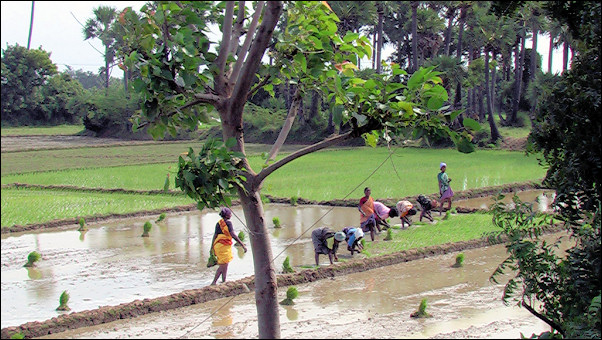
The road to Thanjavur is long and rocky. Along the road rice and sugarcane are grown. We stop to take a look at the rice harvest. The houses in this village are made of palm leaves. Cows and goats roam free.
It doesn't look rich, but we see a color TV in one of the houses. Those are often donated by political parties.
We visit the temple of Gangaikondacholapuram. Outside is a gigantic statue of Nandi, the bull god, which has been carved from one stone. Near the temple, a water buffalo seeks refreshment in the water; this way, it's also rid of those pesky flies for a while.
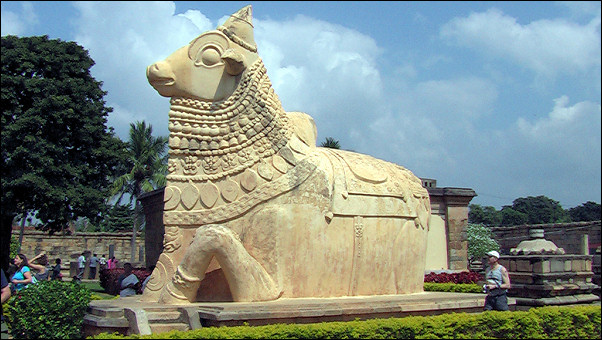
We also visit the Darasuram temple compound which has richly decorated columns. The meaning of the sculptures is explained to us, but I can't remember everything.
In Thanjavur is the Sri Brihadeshwara temple. The stone walls of this temple are incredibly beautiful and richly decorated. In almost every stone a deity is carved out. When one realizes from how far the stones were brought, on can't help being impressed by the scale of the project.
The temple compound is an oasis of quiet. Because of its high walls, the noise of traffic - which is heard everywhere else - doesn't penetrate the compound.
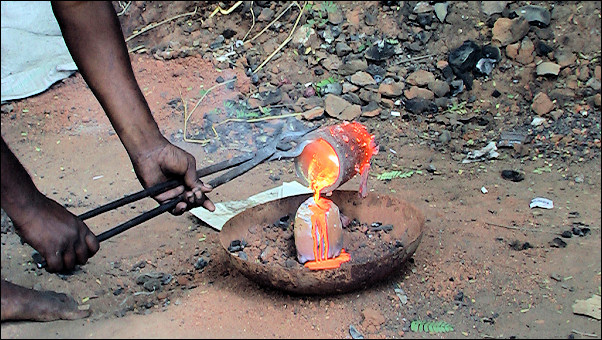
In a bronze-casting workshop we see how bronze statues are made. First a statue is made of a clay-and-oil mixture. It's put in the over to harden. Then it is used to make a clay mold in wich the bronze is cast. When it's cooled off, the mold is shattered and the cast bronze statue remains. It gets a finishing touch with filing and shining. Chemicals can be used to make the bronze look old.
Trichy
The Vishnu temple is built like a maze
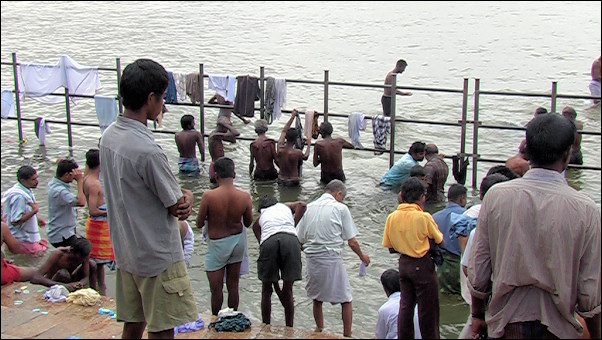
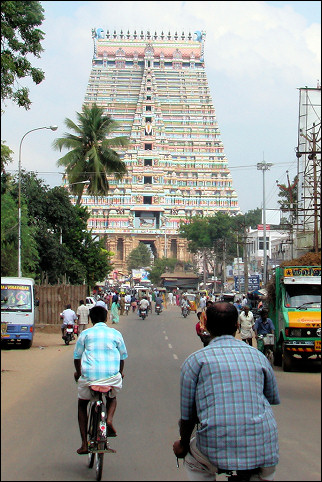
|
On the way to Trichy we pass a place where people take ritual baths. The river banks are not only used for ritual baths and immersions, but also for shaving, blessings by priests and fortune telling.
When we arrive in Trichy, the first thing we notice is the Srirangam temple, because it rises high above the city and is also multi-colored. Inside the outer wall, it looks more like a shopping street than a temple. Only after the third wall we have to take off our shoes and then enter the sacred space.
It's crowded. Moreover, the temple is built like a maze. Very different from the serenity we found in the Sri Brihadeshwara temple yesterday. This temple is devoted to Vishnu. It's the only temple where Vishnu rides a five-headed serpent. The statue is in the holiest part of the temple, which is not accessible for non-Hindus.
Kodaikanal
Biking and hiking in the cold mountains
On the local market we visit on our way to Kodaikanal, cattle is bought and sold, mainly sheep and goats. The merchandise is inspected closely before buying.
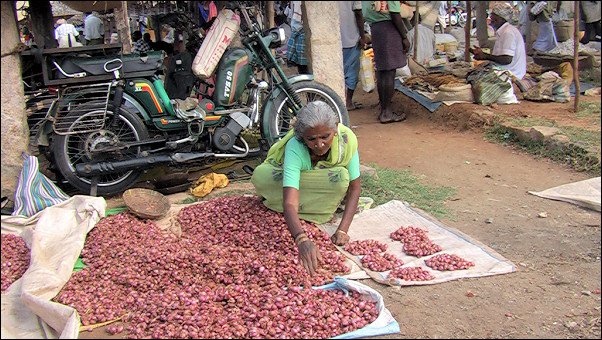
A little farther vegetables, fruit, herbs and houseware like bowls and colanders are sold. Most vegetables and fruit are grown by the vendors themselves. They need other products, so there is barter trade.
The bus begins its long climb to Kodaikanal, which lies at an altitude of 2300 meters. It's much colder here than down in the valley. During the day, the temperature is 21-25 degrees centigrade and at night it cools down to 8-15 degrees.
I rent a bike to explore the surroundings. During my first descent it turns out that the brakes are defective. I almost run over two people who cross the road without looking. The guy in the bike rental place fixes the brakes and then I'm ready to bicycle around Kodaikanal Lake.
Next day I take a walk by myself. Outside the city center are a church and the Mariaman temple. Soon I'm walking down hill, with a wonderfull view of the houses built on the mountain slopes.
The church is easily found, it stands out against its surroundings. The road to it is quiet, there is practically no traffic here. Groups of school children in uniform greet me cheerfully. They want to know my name and where I come from.
The church is simple and inside it's decorated with X-mas streamers, it's just after X-mas. A mosque sits brotherly next to the church.
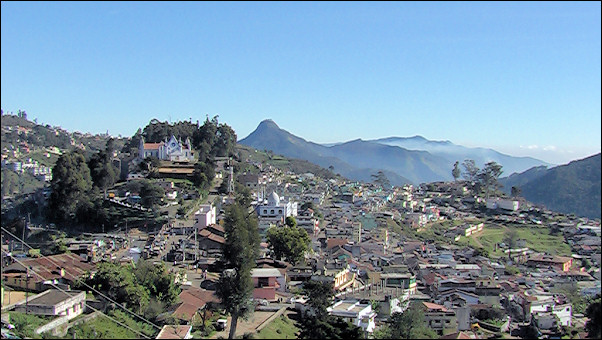
I can't find the Mariaman temple. There are more roads than my map shows. I decide to give up, I wouldn't be the first person to find out after a long descent that the way up is more taxing than expected.
Women are doing laundry and on the clothes lines hang long rows of drying laundry. It seems to be the laundry of one of the hotels. In front of her house, an old woman is ironing with a flatiron which is heated with coals.
The road back up turns out to be heavier than expected indeed. It's really hot meanwhile and within an hour I have drunk all the water in my one liter bottle. I follow the example of the local population and frequently take a break to rest.
Back in civilization, I spot a van which serves as a taxi. For 60 Rs (about 1 euro) it takes me to the top, where our hotel is.
Next I take a look at the lake. From the corner of my eye, I see a kingfisher, sitting on a nearby electricity cable. A multi-colored little bird, which needs a high-quality habitat.
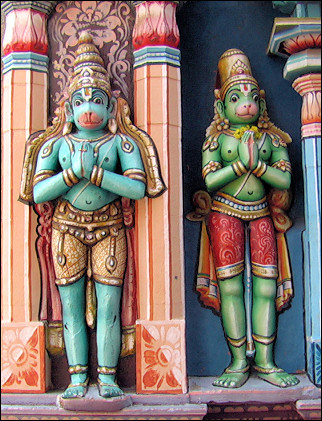
|
Then it's time for a drive along beautiful viewing spots, like Green Valley View (formerly Suicide Point), The Pillar's Rock and Coaker's Walk.
Coaker's Walk is a great hiking trail. When we're enjoying the view, an Indian man approaches us and asks if he can take a picture of me with his son. We don't mind. His wife runs up to us: she also wants to be in the picture. She puts her arm in mine and the three of us are photographed.
Back at the bus we have to wait for our guide. I pet a kind of shepherd dog which belongs to one of the vendors. When I challenge the dog to play around, allowing it to bite my hands gently, while I pinch its snout and paws, Indians surround us to watch the spectacle.
Back at the hotel there is one thing left to do. Saskia brought children's clothing, which we take to the orphanage. The kids want to shake our hands and know our names. Boys and girls sleep in separate, crowded rooms. The bunk beds are all pushed against one another. Still the children seem happy. They get an education, food and shelter here. But when I see how they respond to us, I think they don't get much affection.
Thekkady
Periyar nature reserve with mountains and tropical rainforest
Early in the morning the bus begins its descent from Kodaikanal. On the way, we have to stop a few times to let the brakes cool off. That's a good thing, because there are panoramic views and waterfalls with playing monkeys.
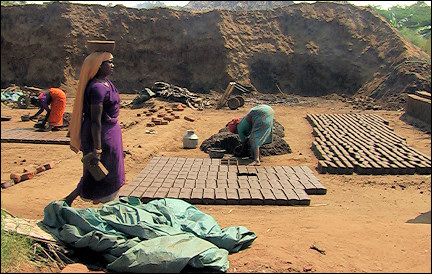
|
On the way we see women making bricks with their hands. Clay is pushed into molds. After the mold is removed, four bricks remain. They first have to dry in the sun and then are baked in a wood stove.
A little farther sugarcane is processed into sugar. That is a matter of squeezing out the juice, boil it down, add bicarbonate of soda to make contaminants surface, and then keep boiling until it's almost solid.
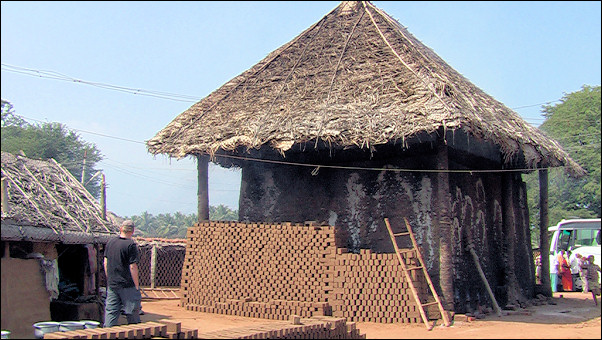
On arrival in Thekkady we are taken on a spice tour. We see how pepper, cardemom, vanilla and other spices are grown, but also coconut palmtrees and rubber trees.
Thekkady is a village with one main street. It owes its existence mainly to its location near the Periyar nature reserve, a mountainous area with tropical rainforest.
This morning we take a boat ride on Periyar Lake, unfortunately not in a rowing boat, as we expected, but in ships that hold 50-100 people. There is no chance at all that we'll spot game, as everyone yells at family members on the other side of the boat when they think they see something. So we only see birds and some otters.
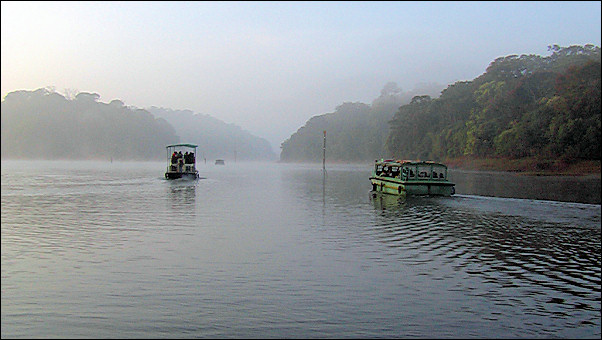
The three-hour trekking in Periyar National Park is much more relaxed. A group of people who hike in the woods with a guide, silent or speaking very softly. There are hard parts, like a long stretch upward. We see some monkeys and a grazing water buffalo. We also find elephant dung and tiger footprints.
Because it's New Year's Eve, there is a buffet and music in our hotel. Just before midnight everyone starts dancing. There are loud fireworks and everyone wishes each other Happy New Year.
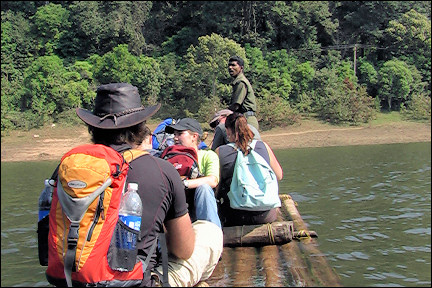
|
The night ends in a strange way. When I'm in my room, I hear excited shouts outside. It's clear that there is a fight. I see young Indians walk around with iron bars and yell. The hotel staff seems to try to keep them from entering the hotel.
Later I hear that it started with a disagreement, in which a flirtation between a girl in our group and an Indian, our supposed use of alcohol and other misunderstandings played parts. Rozario, our guide, was knocked out by a stone.
Kochi: rich and poor
Chinese fishnets are pulled up by a lever
It's a long drive to the port town of Kochi, formerly Cochin. It takes us five hours to cross a distance of only 200 km. Along the road tea (orange peku), rubber and pineapple are grown.
The best tea is hand-picked by women who only pick the upper three leaves. When tea is picked by machines, they sometimes pick 4 or 5 leaves. The best tea is exported. Here only tea of inferior quality is available.
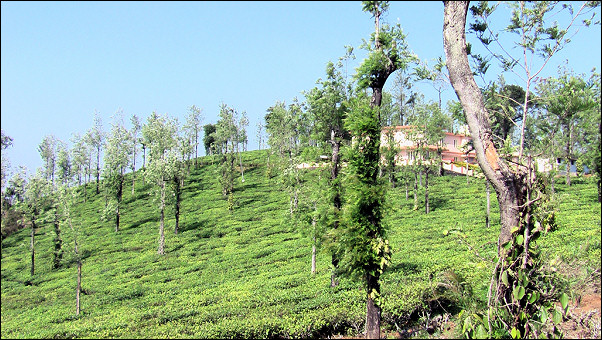
Coffee is also grown here. Originally coffee plants were allowed to grow into trees. They learned from the British how to keep the plants low, shrub-size, which is much more convenient for harvesting.
When we get near the Kerala Backwaters, the landscape slowly changes. Everywhere palm trees grow on the sides of the road.I
People here, in the province of Kerala, are clearly wealthier. It shows in the roads, houses, cars, billboards (luxury items instead of first necessities) and stores. There are many cell phone and jewelry stores and also a specialized business for pet food.
Kochi itself is a big, crowded city with four-lane roads. There are no cows or goats on the road here. We see those only when we are on the way to Fort Cochin. The city is built on a laguna and we have to cross by ferry.
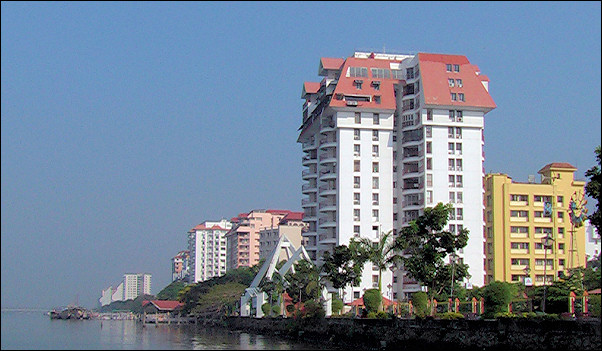
After half an hour we get off the boat and arrive in what seems to be a different city. The luxury has given way to the poorer India. A walk to the Dutch Palace takes us along dilapidated but photogenic buildings.
The route to the synagogue (Kochi has an over 2000 years old Jewish community) leads through a street with on both sides stores with carpets, woodcarvings and bronze sculptures. The quality is better than anything I've seen during this vacation. Very little kitsch and a lot of antique-looking items.
We take a look at the famous Chinese fishnets. These are let into the water with help of a lever and after a while quickly pulled up again. Fish who happen to be swimming over the net, are caught. Several men are needed to move the nets.
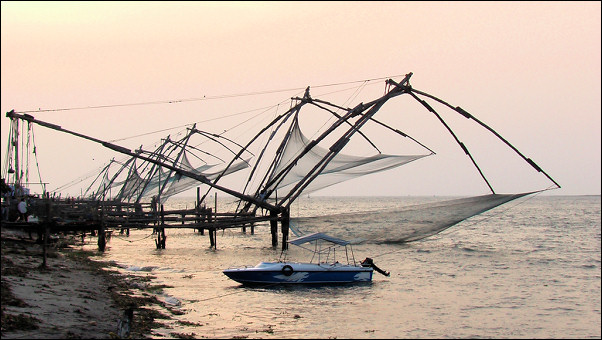
It's a cats' paradise. So much fish is left over that a big population of cats can feed on it. And it looks like a whole lot of crows, too.
The few dogs which are lying in the sun also look well fed. One always has to be careful with strange dogs, but when I cautiously squat, all three rise to greet me enthusiastically.
When I order a beer on a terrace, it's served in a mug. The owner doesn't have a liquor licence, so he has to do this surreptitiously.
Backwaters
The friendly population lives on and in the water
In Allepey we board a boat for a three-hour trip throuh the Backwaters to a resort on the island of Thiruzunnapuzha. The surroundings are beautiful. Everywhere are banana and coconut palms. A little farther we see rice fields. The population lives on and in the water. Dishes and laundry are washed in it and men dive to the bottom to mine sand for house construction.
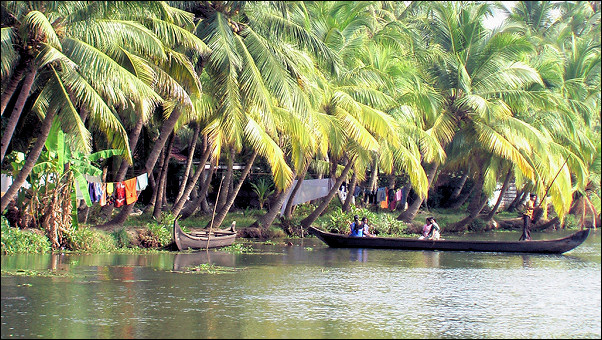
At a certain moment we hear music from speakers. Our resort is unfortunately withing their reach. With every break we hope that it's over. The crows which are nestling in the palm trees try to drown out the music with their screeching.
It turns out it has something to do with a temple festival. In the evening there is a concluding celebration. We see a beautifully decorated elephant walk through a corridor of oil lamps toward the temple. Then there is a dance in which a statue on a chair, representing the devil, is chased away by Shiva. The evening ends with fireworks.
A walk through the village gives some insight in village life. The population is extrememly friendly; they don't just greet us, but also don't mind when we walk onto their property. Even better, they often invite us to come and have a look.
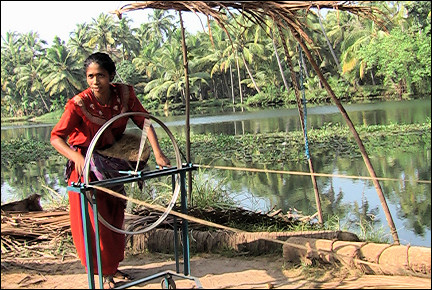
|
Everywhere coconut fibre is spun on some kind of spinning wheels into threads. These threads are used to braid cocos mats.
We take a few paths, which usually have a dead end. We are seperated by a wide ditch from some women who invite us to come over and have a look. We have no idea how to get there. A little girl runs toward us through a field of coconut palms. We take the same route and arrive at what looks like a local restaurant, where we are invited to sit down.
We are invited in by a Muslim family. Bananas and soda are put on the table. We are not afraid to eat bananas, but we politely refuse the soda. If it was made with tap water, it can make us sick. It bothers us that we have to refuse.
By the end of the afternoon we take a ride with a punt on the narrow canals of the Backwaters. It turns out there is an electricity plant close to our resort.
Kovalam
Pretty beach, pushy vendors
Kovalam has one of the most beautiful beaches of India. The view is great and the sand is white, which is not the case everwhere. But there are also extremely pushy vendors. In the hour that I spend there, they try to sell me bananas, salads, hats, drums, shawls, saris and more. It doesn't help to say "no" or to pretend to be asleep.
Fortunately they don't go to the terraces. With a cold beer (in a mug) I enjoy a beautiful sunset. Now Indians are going to the beach. They have the good sense to stay away during the hottest time of the day. Women go into the water with all their clothes on.
A walk to the fishers village proves that behind the luxury hotels there still is the poor India. The houses are very simple. Tourism is the main source of income in Kovalam, which is also clear from the pushiness of kids who keep stubbornly asking for pencils and other stuff.
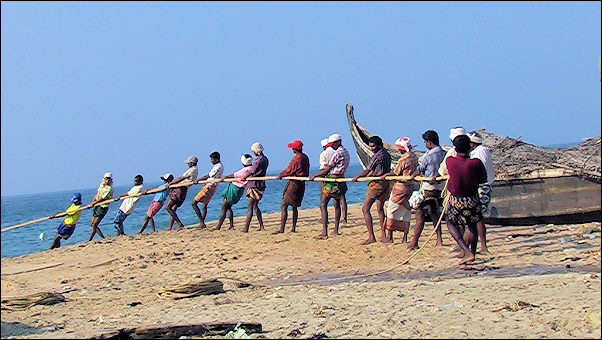
We see how the fish is brought in by boats, but also in nets pulled ashore with long ropes. The fish is sold on the spot.
Christians, Muslims and Hindus live seperately in their own neighborhoods, which each have their own fish auction.
Madurai
The Meenakshi temple compound has no less than 12 towers
In the evening we watch a ceremony in the Meenakshi temple in the pelgrim town of Madurai in which the Shive deity is led to the bedroom of his wife Meenakshi with much pomp and circumstance.
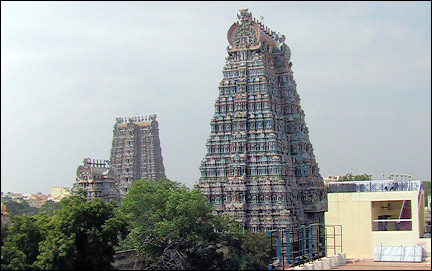
|
Next day we return to this stunning temple compound, which has no less than 12 towers. There are four entrances: north, east, south and west. Every tower is decorated with colorful sculptures, thousands of them. There are also two golden domes.
The size of the complex means one has to be at a high-lying spot to have some kind of overview. Some of the souvenir shops have these viewing spots and one is shrewdly led there.
In the afternoon we take a rikshaw tour of the city. We go through the narrow streets of Madurai along a banana market, an onion market and a pots-and-pans market.
We visit the Ghandi museum, which has many original photos and a lot of information. It helps if you know a little about Ghandi's life.
Mamallapuram
The drumming turns out to be part of a mourning ritual
At 6 AM we leave our hotel for the long train ride to Mamallapuram. We travel second class, which means sitting on hard benches which seat three people each. Fans on the ceiling and open windows are supposed to bring some cool. The doors remain open for the greater part of the trip. People stand in the doorways and now and then lean out. It is no longer allowed to travel on the train roof since some trains now run on electricity.
Vendors walk the aisles with coffee, tea and food. Unfortunately over half of our group are sick, nauseous and/or have diarrhoea.
On arrival at our station we have only two minutes to get our luggage (and our selves) off the train. It just won't wait any longer. Vans take us to our resort.
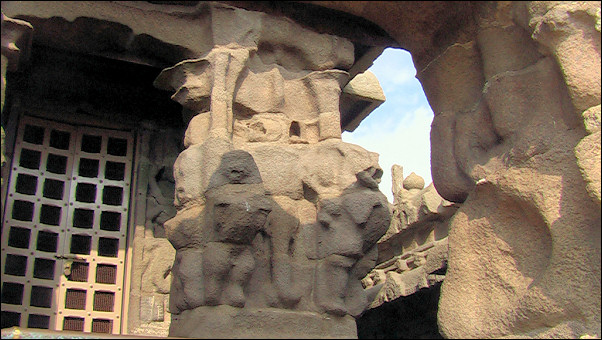
Even though all temples are within walking distance, we rent bikes. The Shore Temple is a must. It was built in the 7th century and has two sanctuaries, one for Shiva and one for Vishnu. Unfortunately most of the sculptures are weather- beaten, but we can see how impressive the temple must have been.
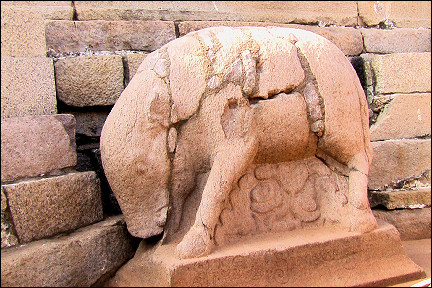
|
A group of squirrels (that's what I call them, because that's what they kind of look like) lives in the temple. The animals are adroit at climbing the stone walls.
While we're biking, we pass other temples. The landscape is rocky. Sometimes rocks were used in the construction of temples.
In one of the streets of Mamallapuram stone statues are made. Hammers and chisels are used, but also square grinding machines. On the other side of the street, in front of the shops, the finer work is done: filing, polishing, painting and decorating.
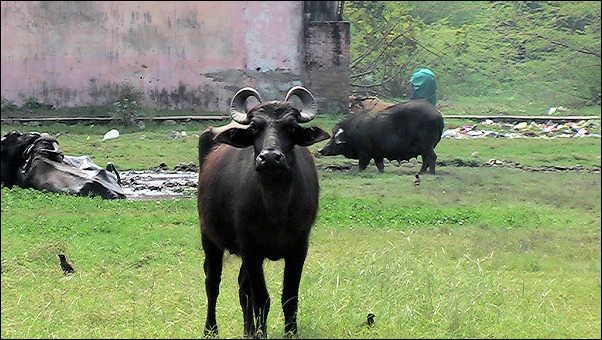
On our biking trip we see a field full of water buffalo. We want to take a picture. An opening in a cactus fence offers a prickly passage. One of the bulls keeps an eye on us and tries to sniff our scent. We're not completely at ease, but as long as it keeps its distance we dare to stay.
Almost back in the village we see a group of men enthusiastically beat drums. We're curious and decide to take a look. It turns out not to be a festive occasion, but part of a mourning ritual. On a table in the street an old woman lies in state; she died this morning. The family sits around her in mourning. We are still welcome to watch.
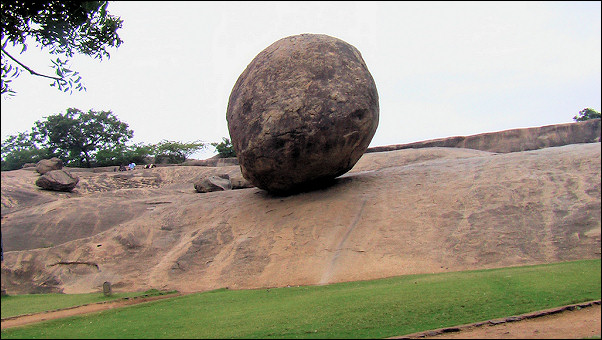
Arjuna's Penance is a gigantic bas-relief, carved in rock. We see Krishna's Butterball, a huge, almost round rock which seems about to roll down any moment.
A young student forces himself on us as a guide. After the tour, he invites us to take a look in his school. He turns out to be an art student and shows us his drawings. There are carved stones against the walls.
When Saskia asks him about the prices of two sculptures, the amount he gives is so high that negotiating is useless. When we leave, he follows us with two smaller carved stones. He says they're 50-75 Rs each, but when Saskia picks two, all of a sudden they're 350 Rs.
We've had it and decide to give him only 50 Rs for his (unsollicited) tour. Even now he's not satisfied and wants at least 100 Rs. We make it clear that we don't like him anymore and that he can get 50 Rs or nothing. Eventually he accepts the 50 Rs.
Next day we are asked to join an excursion which is still being developed. We are supposed to fill out an evaluation form afterwards.
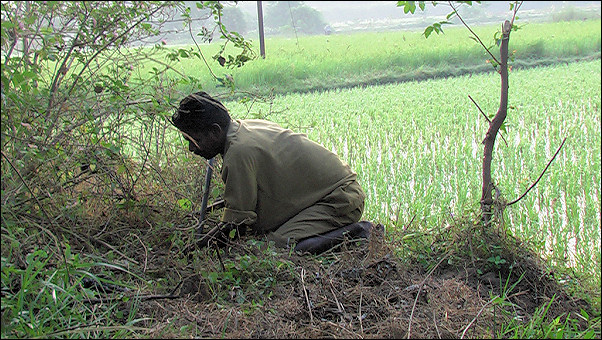
It's a scorpion and snake hunt. Nearby live people who belong to the few who are allowed to hunt snakes. When a snake is caught, its poison is milked. It is used to make an antidote.
Snake are found by digging up their nests with a machete and a crowbar. After some searching and digging they find a black scorpion, followed by a nest with young. Later, a snake is exposed. The poisonous snake lashes out at its attacker, only to withdraw even deeper into its hole.
After this we visit the ITWWS (Irula Tribal Woman's Welfare Society)
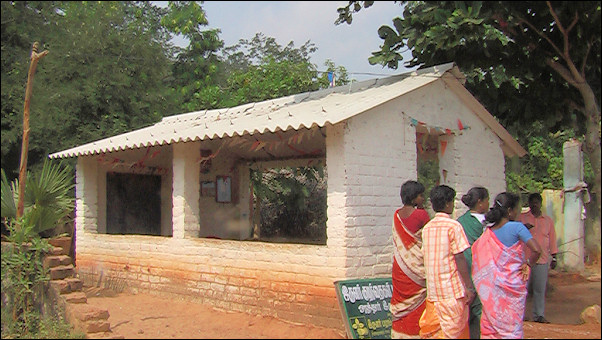
They show us the "house snake." We get a cup of massala tea (not everyone's taste). The ITWWS strives to preserve the traditional knowledge of the women here and use it as a basis for development.
We see how medicinal herbs are grown and visit a village in which the traditional way of life is preserved, while at the same time conditions of life are improved.
This is our last day in India. In the evening we are taken to the airport. Back to the cold in Holland.